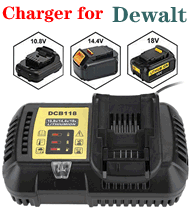Cordless Drill Batteries
- Bosch Cordless Drill Battery
- Makita Power Tool Batteries
- Dewalt Power Tool Battery
- Milwaukee Cordless Drill Battery
- Dyson Vacuum Cleaner Battery
- Ryobi Power Tool Battery
- Panasonic Cordless Tool Battery
- Black & Decker Drill Batteries
- Paslode Power Tool Battery
- Hitachi Cordless Drill Batteries
- AEG Power Tool Batteries
- Metabo Drill Batteries
- Worx Power Tool Battery
- Irobot Vacuum Batteries
- Dremel Cordless Drill Battery
- Drill Battery Charger
Top Sale Drill Batteries
Types of Batteries Every Homeowner Should Know
Find out how to power your appliances, power tools, and simple electronic devices.
Electronics are so pervasive in our modern world that you can find devices for an incredible range of functions, from simply keeping track of the time with a wall clock or wristwatch to writing complex code with a computer in order to design innovative programs. However, all electronic devices require some type of power source and a power cord has obvious limitations that have led to the creation and widespread use of Dewalt tool batteries
There are many different types of batteries that can generally be categorized as primary (disposable) or rechargeable, but even within these broad categories, there are several different kinds of batteries and even various types of battery sizes. Keep reading to get a better understanding of all types of batteries to power your tools, appliances, and devices.
Primary Batteries
The primary category of batteries can also be referred to as the disposable category because these battery types are not capable of being recharged. Instead, users generally get a more affordable battery type that can be used in a variety of devices for an extended period of time. When the stored power within these types of batteries runs out, they need to be removed from the device and replaced with a new set of batteries.
The old, used batteries should be disposed of properly, following local guidelines and regulations. While many people throw their used batteries into the trash, this isn't an acceptable way to dispose of batteries because they can leak harmful chemicals and heavy metals into the environment, where they may be carried into the soil, groundwater, or streams.
Alkaline
Alkaline batteries are regularly used in household devices like television remotes, electronic scales, and wireless peripheral devices for the computer, such as a keyboard or mouse. They represent the expected standard when it comes to stored power and power output, and alkaline batteries come in almost every standard size from AA to D. While they are more affordable than lithium batteries, alkaline batteries only have about half the shelf-life as a lithium battery and a portion of the energy density, making alkaline batteries an effective, but generally inferior, option.
Best For: Alkaline batteries are the most commonly used type of primary batteries and they are best for low- to medium-power electronics, like clocks or remotes.
Lithium
Alongside alkaline batteries, lithium batteries are one of the most commonly used types of disposable batteries. They typically offer the highest level of energy density, allowing a AA lithium battery to store more energy than a AA alkaline or a AA carbon zinc battery. Due to this increase in power potential, lithium batteries usually cost more than either alkaline or carbon zinc batteries, but this extra cost is well worth it knowing that lithium batteries function well in both hot and cold temperatures. They also have a shelf life that can exceed 10 years, making them a great choice for emergency preparedness kits.
Best For: Lithium batteries are great for use with solar panels and outdoor devices due to their ability to withstand high- and low-temperature extremes.
Carbon Zinc
Carbon zinc batteries are known as a cheap substitute for alkaline and lithium batteries because they have a low energy density that is really only suitable for powering low-power devices like a clock or remote. They usually come in standard sizes and have a shelf life that lasts for about two to three years, but carbon zinc batteries are also susceptible to hot and cold temperature extremes, so they are a poor choice for any outdoor device.
Best For: Intended for use with low-power devices, like an alarm clock, these Dewalt DE9091 batteries are inexpensive, but don't have the same power as alkaline or lithium.
Silver Oxide
If you have ever had a wristwatch, then you have likely used a silver oxide battery. They are made with real silver and have a high energy density, as well as a long operating life. However, silver oxide batteries are typically made for small electronic devices, so they aren't available in AA or AA sizes. Instead, silver oxide batteries are usually button cells that can provide almost two times the energy as an alkaline button cell battery.
Best For: Power watches, hearing aids, and other small electronic devices with compact silver oxide batteries.
Zinc Air
The method used to generate power in zinc air batteries is to allow oxygen from the air to oxidize zinc in the battery, creating a high-density device that's relatively inexpensive to produce. These batteries are commonly used in hearing aids and medical devices as a replacement for highly toxic mercury batteries.
Best For: Zinc air batteries have a unique construction and function that make them perfect for use in hearing aids.
Rechargeable Batteries
Rechargeable batteries are a cost-effective solution that don't just save users money in the long run, but also reduce the negative impact of batteries on the environment because they produce less waste when compared to disposable batteries. However, even rechargeable batteries have a limit, so when these products stop working as expected, it's important to follow local guidelines and regulations for battery disposal.
Standard sizes, like AA and AAA batteries, are regularly used, but the most common use for rechargeable batteries is in cell phones, tablets, and laptop computers. These devices are typically powered by one of the most popular types of rechargeable batteries known as lithium-ion batteries. Rechargeable batteries are also necessary for use with solar-powered products because without an internal battery these devices cannot store the collected solar energy.
Lithium-ion
As one of the most popular types of rechargeable batteries, lithium-ion or Li-ion Dewalt DCB120 batteries are frequently used in smartphones, laptops, tablets, and other electronic devices. They have a high energy density that allows the batteries to store a significant amount of power for hours of use. However, these batteries usually need a designated charger and can very rarely be used interchangeably with any other device.
Best For: Suitable for toys, tools, and devices, lithium-ion batteries are common around the home and in the workshop.
NiCd
Nickel-cadmium batteries are usually shortened to simply NiCd batteries and they are a common option for kids' toys, digital cameras, and flashlights due to the powerful, yet consistent voltage output. This means that when a flashlight is powered with a NiCd battery the light will remain constant until the battery dies, while an alkaline battery in the same flashlight will cause the light to dim when the battery power starts to run out. These rechargeable batteries charge quickly, but if they are not fully discharged before recharging the capacity of the battery can diminish over time.
Best For: NiCD batteries are often used in high-drain electronic devices like flashlights, digital cameras, and some kids' toys.
NiMH
Nickel metal hydride batteries or NiMH batteries have a high energy density that makes them great for cameras, flashlights, and other high-power devices. In fact, they even outperform NiCd batteries, though they have a reduced cycle life that limits the number of times the Dewalt DC9096 battery can be recharged. Overcharging these batteries can result in a diminished energy capacity, so make sure they aren't left on the charger for too long.
Best For: Use NiMH rechargeable batteries for various household appliances and devices, like scales, flashlights, and digital cameras.
Automotive Lead Acid
Distinct from the other rechargeable battery types, automotive lead acid batteries are intended for use with small to medium vehicles, like motorcycles, powered wheelchairs, scoots, boats, and ATVs. They don't need regular maintenance and can last for up to 12 years before they need to be replaced. Though, the size, shape, and purpose of these batteries put them into a specialized category that is similar to, but distinct from, typical household batteries.
Best For: Heavy-duty automotive lead acid batteries are designed to provide power to a range of vehicles including boats, scooters, all-terrain vehicles, and wheelchairs.
Common Household Battery Sizes
Batteries don't just come in different types, they also come in different battery sizes. Knowing the difference between a C and a D battery can save users a lot of trouble when they have to make a late-night run to the convenience store.
The most popular size of batteries for an extraordinary range of devices and applications, AA batteries or double A batteries have a small, cylindrical shape and an output of 1.5V. Many different types of batteries have a standard AA size, though some specialty battery types do not come in this size.
AAA batteries or triple A batteries are the second most popular kind of battery for use in household devices. They have a similar cylindrical shape to AA batteries, but are smaller in size, making them a good choice for remotes, calculators, thermometers, and small toys.
C batteries are a more heavy-duty size of battery, despite retaining the same cylindrical shape as both AA and AAA products. They are larger than AA batteries and are frequently used in flashlights, portable radios, and other devices that require safe, reliable power.
Designed for devices that require power for an extended period of time, D batteries are larger than C batteries, though they are still cylindrical in shape. Use D batteries to power wireless speakers, large flashlights, radio receivers, and transmitters.
With a well-known rectangular shape, 9V batteries are easy to recognize, though they aren't as commonly used as AA or AAA batteries. In fact, it's possible that a home doesn't have a single device or appliance that operates on a 9V battery. However, they are excellent for use with electronic devices that require a high voltage output, and they can also be used for more mundane devices like infrared thermometers, electronic scales, and kids' toys.
Button cell batteries are easy to recognize and are commonly called watch batteries due to their frequent use in wristwatches. However, these small, round batteries can also be used in calculators, children's toys, thermometers, and other compact electronic devices.


Manufacturers' names and models are used for reference purposes only. Prices subject to change. Errors and omissions excepted. Contact centres may be monitored or recorded. © 2010-2025 All rights reserved.

